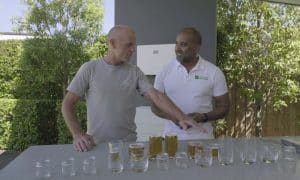Sharp Corporation has claimed to have achieved the world’s highest non-concentrator solar cell conversion efficiency of 35.8% using a triple-junction compound solar cell.
The conversion efficiency was confirmed by the National Institute of Advanced Industrial Science and Technology last month.
Unlike silicon-based solar cells, most commonly used in solar panels for the home solar power market, the new Sharp solar cell utilizes multiple light absorbing layers made from compounds including indium and gallium. Compound solar cells are expensive to produce and are mostly used on space satellites.
Usually Ge (germanium) is used as the bottom layer in triple junction solar cells, but while germanium generates a large amount of current, the majority of the current cannot be converted to electricity and is wasted. Sharp has worked around this issue by forming the bottom layer from InGaAs (indium gallium arsenide), a material with high light utilisation efficiency.
As a result, the amount of wasted current has been minimised and Sharp has been able to boost conversion efficiency of their solar cells from 31.5%, which the company achieved in 2003, to 35.8%.
Sharp has been in the solar cell business since 1967 when it began developing modules for space applications using monocrystalline silicon. In 2007, Sharp achieved a conversion efficiency of 40.0% for a triple-junction compound concentrator solar cell (at 1,100 times concentrated sunlight).
The company also caters to the residential solar power market and Sharp’s grid connect solar panels currently have a conversion efficiency of around 13.7%.









































